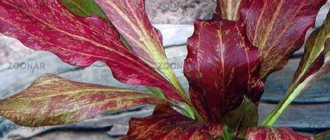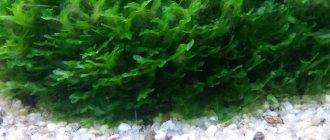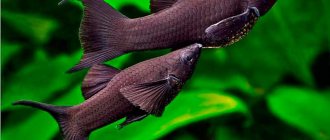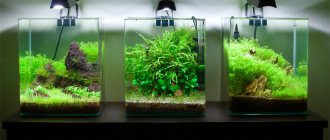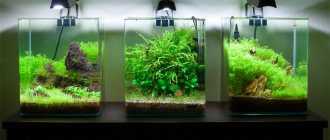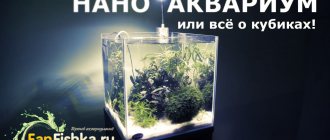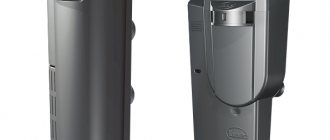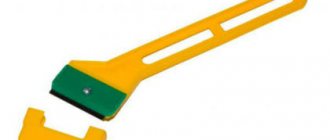Rotala indica is a widespread aquarium plant that has gained its popularity due to its beautiful leaves and flowers. It has several variations of the name, the most common among them: ammania bonsai, “Indian tooth bowl”.
In its natural environment, it is found in freshwater bodies of Asia, India, China, Japan, Vietnam and other territories. It is bred artificially in the rice fields of Africa, Italy, Portugal, and the USA. Ammania bonsai is an annual plant.
Spreading
In nature, it is mainly found in Asia. Distribution area: India, Sri Lanka, Philippines, Japan and China. Prefers moist places - grows in wetlands and rice fields.
Ammania, growing in natural conditions, does not take root in aquariums - a special form was bred for this.
Description
Ammania bonsai belongs to the genus of herbaceous plants. Family – Derbennikovaceae. The birthplace of the culture is West Africa. In nature, the plant can be found growing along river banks and in flooded areas. Many aquarium owners know this culture as Rotala Elatinamorpha. However, it also has a number of other names:
- Amelenia Uliginosa;
- Amelethia Indica;
- Rotala Indica.
Representatives of this genus are a specially bred product of breeding work. It is preferable to grow it in small aquariums, placing it along the walls. In this case, Ammania bonsai creates the mesmerizing effect of a beautiful carpet. Due to its appearance, it is often used as a decoration for a small aquarium.
Growing and care
Ammania bonsai is one of the most demanding and demanding aquarium plants.
For normal growth and preservation of the decorative appearance of leaves, it is necessary to regularly check the water parameters and comply with the maintenance conditions.
Water parameters for ideal maintenance
In water with high acidity, a hardness level below 6° and above 17° dH, Ammania bonsai dies.
Installation of filters and regular water changes of at least 1/4 of the aquarium volume are required. It is desirable to supply CO2, which has a beneficial effect on the growth and appearance of the plant.
Plant temperature
The plant will not develop at high or low temperatures - the range should be between 23-27 degrees. The temperature regime should be maintained constantly, since Ammania bonsai dies quickly, and it is extremely difficult to “reanimate” it.
To check the acidity of water, you need to acquire special tests, since this parameter can change. It is especially important to control this parameter when using tap water.
Lighting requirements
Special requirements apply to lighting. To form reddish leaves in the upper part of the bush, bright light is required - at least 0.5 W/l. With insufficient lighting, they lose color, and the plant stretches and loses its decorative effect.
Requirements for soil and nutrient substrate
The optimal soil for Ammania bonsai is river sand or fine gravel, a layer of at least 1.5-3 cm.
A nutrient substrate is optional (the plant receives most of the substances necessary for growth from water), but it contributes to better survival of the bushes.
Requirement for fertilizers
The plant requires regular application of nutrients in liquid form. Mineral complexes containing iron, nitrates (about 5 mg/l), phosphates (1.5-2 mg/l) and microelements are used as fertilizers.
Fertilizers are applied as indicated in the instructions (depending on the manufacturer) when changing the water in the aquarium.
While maintaining the water parameters necessary to maintain Ammania Bonsai, it is important to ensure that the rest of the aquarium inhabitants are also doing well.
Artificial bonsai for aquarium
For those who want to create a unique bonsai in an aquarium right now, and not wait several years for the tree to grow and not waste energy on shaping its bizarre shape, there is a much simpler option - an artificial dwarf tree. You can purchase it in our store in the artificial bonsai purchasing section, or you can work hard and make it yourself.
It is easier to form an artificial bonsai than a real one; you just need to find a small dried dwarf tree or rope. It is necessary to take into account the fact that the wood that will be used to create a bonsai must be from tree species that do not rot in water, for example: breadfruit, willow, mangrove, etc. When creating a composition, you should remember not only about the shape of the trunk for different bonsai styles, but also take care of creating the original crown, which is the distinctive feature of these dwarf trees. To form the crown, Java moss is used, which gives the entire composition the most realistic and lively appearance. In our online store we offer ready-made solutions - a handmade bonsai tree made from breadfruit.
You can add fish and other animals to an aquarium with an artificial bonsai, although at this point you need to be careful to maintain the style. An artificial bonsai tree for an aquarium looks quite naturalistic, is easy to care for, and you don’t have to shape and trim it for many years trying to achieve the ideal shape. Those artificial bonsai that are on sale are made from waterproof, non-toxic materials, so they will not harm other inhabitants of the aquarium. Buy bonsai driftwood in the online store marlin-shop.ru >>
Reproduction
Ammania propagates by cuttings.
After trimming the top part of the plants, it is planted in the ground at a distance of at least 3 cm, otherwise the growing bushes will interfere with each other. Don’t forget that growing bushes can shade your neighbors.
After planting, it is necessary to carefully monitor the water parameters - young plants take root well, but if left untreated, they quickly take root.
Breeding and planting methods
The plant is propagated by cuttings - the top is cut off, which is planted at some distance from the main bush. This way the cutting will receive enough light and nutrition.
Acclimatization of the cutting can take a long time, depending on how well it is cared for. When planting in the ground, you should follow the “ladder” pattern. After about 1-2 months, the cuttings will grow 1-2 cm.
You can propagate the plant using cuttings using the same principle in a separate container with soil and water. After strong shoots with round leaves form above the water, they are planted in a permanent place.
Forms of ammania
The Ammanium genus is diverse and includes more than 20 species, but the following forms are used when decorating aquariums:
graceful (Gracilis)
Senegalese
Multiflora
Sulawesi
All varieties of plants are demanding in terms of maintenance conditions - they require high temperatures and good lighting.
Despite this, they are popular among subscribers due to their bright colors - the leaves are green with a reddish tint.
Ammania bonsai in aquascaping
The advantage of Ammania bonsai is its versatility. In nano-aquariums it is planted in the background and middle ground, in large tanks - in the foreground.
Plants grow and form beautiful lush meadows. Ammania grows slowly, so it rarely needs trimming - 2/3 of the plant is cut off during trimming.
Tips from famous aquascaper Arend van den Nieuwenhuizen
To create a harmonious design, the aquascaper advises planting Ammania bonsai next to plants that differ in the shape of the leaf plate. Ludwigia has similar oval leaves with a reddish tint, so it will not look the best next to the plant.
Ammania should be “diluted” with pinnate or alternanthera. You should not create contrasting spots from plants - the transition should be smooth, with dark plants placed in the background and light plants in the foreground.
Arend van den Nieuwenhuizen
Aquascaper
Ammania bonsai should not be planted in aquariums where goldfish or other inhabitants who like to eat plants live. Its stems are very fragile, so predators and overly large, active representatives of the fauna can easily damage them.
— Arend van den Nieuwenhuizen Aquascaper
Placement in an aquarium
Ammania bonsai takes root well in a new place and participates in the metabolic process in the environment.
This is a beautiful aquarium plant that is used in containers of different sizes. Rotala Indica is most often used to decorate the middle, back line. When decorating large aquariums, the plant is suitable for decorating the middle, foreground.
To create a visually beautiful background, you can direct the lighting from the back wall of the aquarium, highlighting the rotala indica from below. Then the leaves turn red.
In an aquarium, these plants are planted in groups; individual specimens look bad. Ammania bonsai, driftwood, and stones complement each other perfectly.
It is necessary to take into account that the plant has fragile stems, so it is better to remove them away from the filter or aerator. Otherwise, the flow of air-saturated water may harm Rotale Indica. For the same reason, proximity to active large aquarium fish is not advisable.
Possible problems
Difficulties in growing plants arise when water parameters change, insufficient lighting, and deficiency of carbon dioxide and microelements. Ammania becomes pale, stops growing and soon dies.
In addition to unfavorable conditions, bushes sometimes suffer from pests and diseases. These include water aphids and blackbeard algae.
To destroy aphids, green soap (20 g) and copper sulfate (1 g) are used - the components are mixed and the diseased plants are treated with the solution, after removing the fish. After the insects die, the bushes are washed and placed back.
You can fight the “black beard” in different ways. Introduce Siamese algae eaters into the aquarium, use special preparations (for example, AlgoStop Depot).
True, not all representatives of aquafauna tolerate such exposure - many of them quickly die under the influence of chemicals.
Ammania bonsai is a capricious plant that quickly gets sick and dies under inappropriate conditions. It is not easy for beginners to cope with it, but if successful, it will become a decoration of the aquarium and the pride of the owner.
Common diseases and pests
Diseases that can affect Ammania bonsai are associated with:
- poor living conditions - lack of light and unsuitable temperature conditions;
- deficiency of vitamins and microelements (iron, potassium, phosphorus, nitrogen, sulfur, carbon dioxide).
The plant may be attacked by pests:
- Water aphid. Small bugs up to 1.5 mm in size live on the leaves, gnaw them, leaving behind black round holes.
- Blackbeard (Compsopogon coeruleus algae). It has the appearance of hard black hairs and grows up to 2 cm in length. It lives on the walls of the aquarium and its plants, destroys leaves and blocks light from them.
Rotala is the best choice for aquarists. But in order to preserve the plant, it is necessary to provide it with proper care and conditions, to equip the aquarium with the necessary devices that serve to support the life of the aquarium inhabitants.

